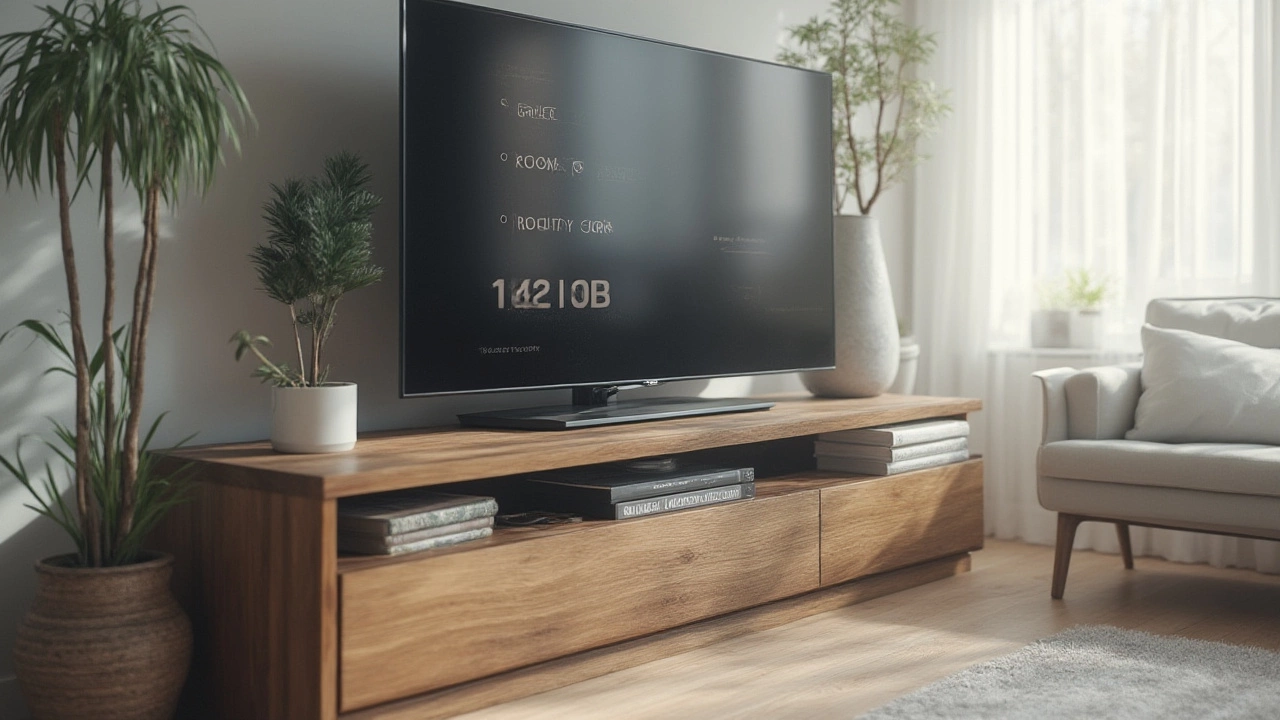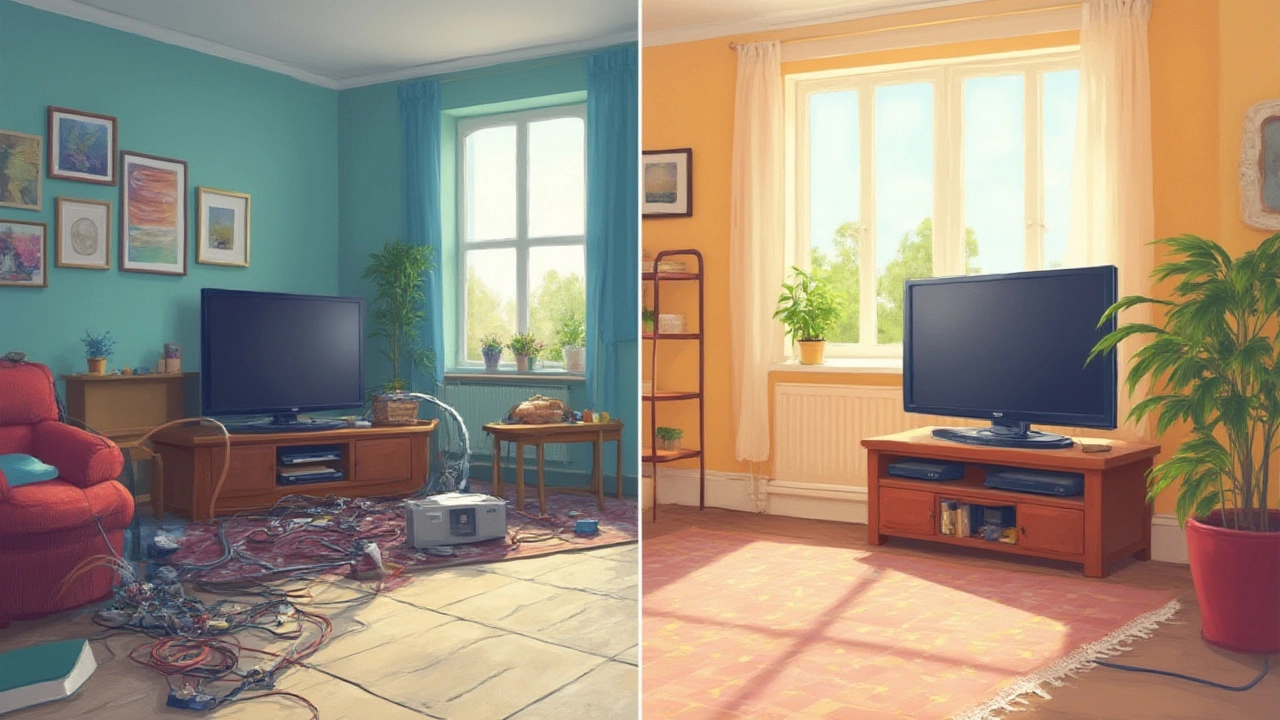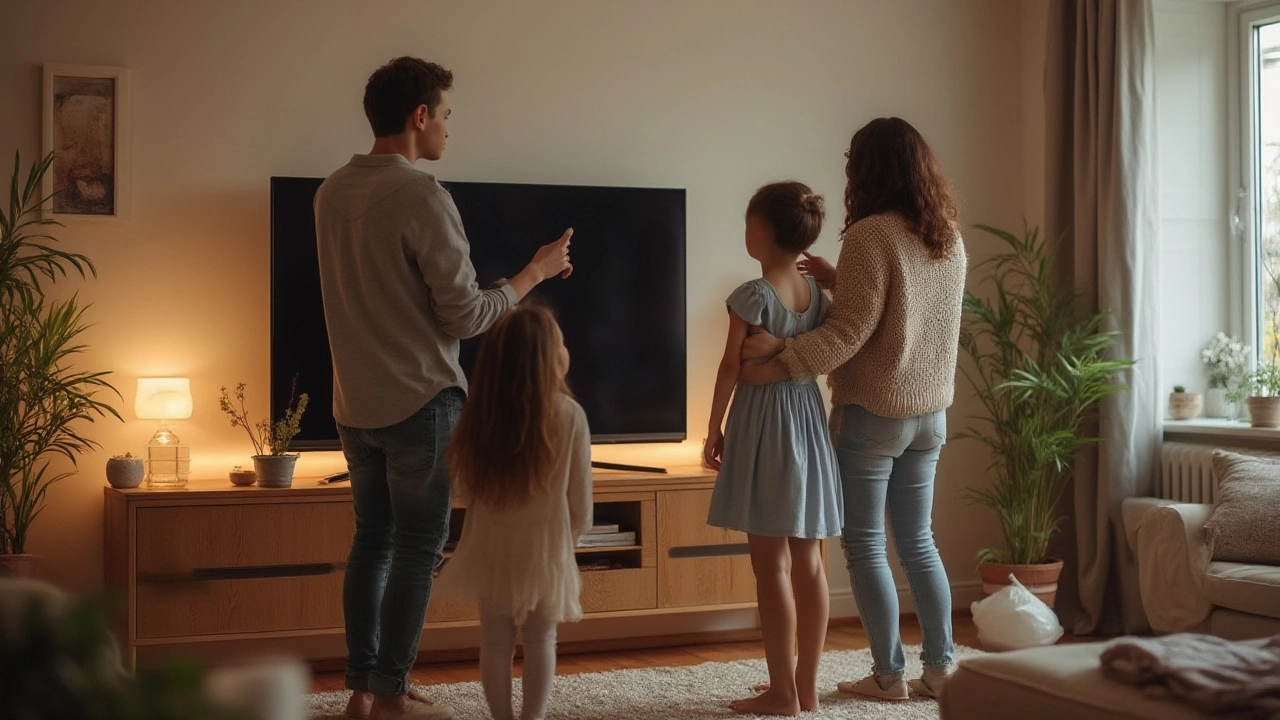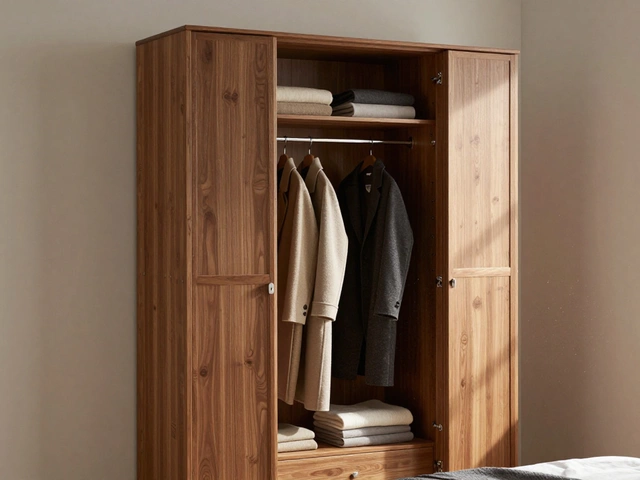If you’ve ever dragged a hefty television through your living room while weaving past coffee tables and piles of shoes, you know the whole TV placement thing isn’t just a minor detail. It changes the vibe of your space. Plop your TV on a stand, and your living room suddenly says, "Sit down, grab popcorn, we’re watching something." But if that black screen is just kind of lurking in the corner or propped up on a flimsy shelf, it screams, “I was an afterthought.” If you’re torn about whether to use a TV stand or not, believe me, you’re not the only one. The choice seems simple but honestly, it changes everything, from how you use your room to how safe your gadgets are. So, is a TV stand worth it?
What Does a TV Stand Actually Do?
TV stands look pretty basic, right? Four legs, a shelf, sometimes a couple of cabinet doors for hiding remotes you never find when you need them. But under the hood, these things do a ton of work. At its core, a TV stand props up your television to just the right height so you’re not stuck craning your neck and straining your eyes. Ergonomics experts—the same folks who worry about your office chair being too low—say the center of your TV should line up right at eye level when you’re sitting down. If you’re curled up on your couch in Mississauga on a cold February night, a TV stand makes sure you’re glancing straight ahead, not up like you’re waiting for flight arrivals at Pearson.
Besides comfort, stands act as a solid, stable base. Most TVs, especially the big screens that are popular since 2020, are much wider and thinner than before. Tip one over, and it’s hundreds—sometimes thousands—down the drain. In fact, insurance claims about TVs knocked over by kids or pets have been on the rise, especially since flat screens became the norm. A proper TV stand helps by reducing the wobble factor and offering mounting options that prevent accidents. Good stands have safety straps or holes for bolting the screen in place, and some even have rounded corners to keep those shin bruises to a minimum.
That’s not the end of their secret talents, though. TV stands are also your living room’s storage superhero. Got game consoles, stacks of Blu-rays, or extra cables with mysterious origins? Slide them into the cabinet. Some folks even use the shelves for speakers, soundbars, plants, or that vintage lunchbox collection. And if you live in a condo or apartment in the GTA, space matters a lot. TV stands with drawers or doors turn clutter into clean vibes fast. Plus, if you rent, you don’t want to poke holes in the wall for a mount. Stands let you move your entertainment center around without going full handyman.
So, a TV stand does a lot more than you’d guess. It boosts comfort, keeps your stuff organized, and can even protect your gadgets from disaster. It’s the secret star of your living room.
The Good Stuff: Reasons To Put Your TV on a Stand
First off, flexibility is a huge win here. With a stand, you’re not stuck with one layout forever. Feel like watching the Raptors from the kitchen while you cook? If your stand’s got wheels, just roll it over. Want to rearrange that open-concept space for game night or entertaining? Stands let you play switcheroo anytime you like. This kind of versatility is gold, especially if you’re the type who loves changing things up every season—put away the Christmas tree, scoot the TV back, and boom, new room.
Another huge advantage is cable management. Modern TV stands often come with dedicated holes at the back to snake your power cords, HDMI cables, or speaker wires. That tangled mess you usually see trailing off the back of a table? Gone. Everything gets tucked away, keeping the room tidy and making your space look like you know what you’re doing. Nobody wants their living room to look like a tech graveyard, especially if friends stop by.
Safety is not just for kids or pets, though it definitely matters if either is running around your place. Properly designed TV stands often have anti-tip features. Even simple stands are heavier at the bottom for stability, which isn’t the case if you just stick your TV on a dresser or makeshift platform. If you check out the policies from big retailers (think Canadian Tire or Best Buy), they’ll tell you to always use a purpose-built stand for insurance and warranty reasons. Crazy, but a lot of people skip this stuff by accident and get burned after an accident.
The kicker? Some TV stands are straight-up gorgeous. Designers and makers have gone next-level since the mid-2010s, with styles for everyone: Scandinavian minimalism, classic wooden cabinets, space-age finished metals, Canadian maple and oak, and even glass models that look sharp in small condos. If you want your entertainment setup to blend in with your decor or become the statement piece, you’ll find something that fits your mood and budget. The right stand can actually lift your whole living room’s look—no kidding.
And then there’s storage, which nobody ever has enough of. Most TV stands come with at least a couple of spaces for media boxes, game controllers, remote controls, or even board games. Some even have built-in slots for DVDs (yeah, those still exist) or shelves made just for your surround sound system. Ever scrambled to find a controller right before movie night? Not a problem if everything has its place in your stand.
So, using a TV stand isn’t just about propping up your TV. It’s about room flexibility, neatness, safety, and turning your living space into something genuinely inviting.

Things To Think About Before You Decide
Sounds like a TV stand is the answer to everything, but hang on—there are a few things to weigh before you go shopping. First, space. TV stands come in all lengths, from narrow, corner-friendly models to massive wall units. If you’re in a downtown Mississauga condo, measure carefully. Leaving just enough breathing room not only looks good but also avoids blocking doors, baseboard heaters, or windows. Even guys who hate measuring tape end up regretting impulse buys when their stand eats up all the legroom.
Next is height. The sweet spot for comfort is when the middle of your TV sits at eye level when you’re sitting down. For most people, that means the stand should leave the screen about 42 inches from the floor. TVs with built-in legs sometimes throw off the math, so factor in the height of your specific model.
Weight’s another issue. Each stand handles a certain load, listed in the specs. With some of the latest OLEDs and QLEDs getting bigger (and heavier), double check before you buy. Buying from a store? Ask for the manufacturer’s max weight limit. Ordering online? Don’t trust marketing—dig into the technical details.
Consider traffic flow, too. Where do people walk through your living room? Kids zooming past during hockey games? Dog doing laps after dinner? Place the stand where it won’t turn into a tripping hazard. If your home is open concept, picture where the sofa, coffee table, and TV stand will actually line up.
Finally, think about your tech. Got soundbars, gaming consoles, or a record player? Stands with adjustable shelves or cable holes make life easier. Planning to add smart speakers, streaming boxes, or routers? Looking ahead saves frustration. Anticipate a bit—living rooms fill up fast.
Oh, and here’s one last real-world check: will you want to move soon? If so, lightweight stands or IKEA flat-packs are way easier to handle than a hundred-pound, solid-wood beast. Trust me, you don’t want to wrangle those down three flights of stairs in February. Take it from a guy who’s watched more than a few moving trucks try.
When a TV Stand Isn’t the Best Choice
Alright, just because stands make sense for a lot of folks doesn’t mean they’re always perfect. Got little ones who love to climb? Even the heaviest stand can tip if someone treats it as a jungle gym. In those cases, you might be better off wall-mounting your TV—just bolt it in place, out of reach, and you won’t worry about accidental tipovers. The Canadian Paediatric Society actually recommends mounts for homes with toddlers, just to cut down on ER trips.
Another downside: TV stands do take up valuable square footage. In smaller city condos, that footprint really adds up. Some folks go for a wall mount and a slim floating shelf just for this reason—it frees up the floor for other furniture or just to keep the space feeling open. Wall-mounting also looks slick, almost futuristic, and your TV becomes art on the wall. Game consoles and speakers can still sit below, but the big clunky cabinet is gone.
Cleaning can also be a pain if your stand has too many nooks and crannies. Pet hair, dust bunnies, and snacks (don’t ask) find their way behind the base, and you’ll be pulling out the vacuum more often than you’d like. If you’re someone who likes a quick tidy-up, check for open sides or built-in cable management trays—some stands are designed to be a pain in the neck for hiding wires.
And then there’s the money. High-quality stands can get pricey, especially solid wood versions. Some families take the budget wall-mount option and skip the extra spend. But keep in mind, basic stands don’t have to cost a fortune. Look for local sales—Mississauga’s got plenty, from big box stores to estate auctions. If you’re patient, you’ll land something stylish without breaking the bank.
Stands also aren’t great if you’re a minimalist who prefers the TV almost invisible. Wall-mounting keeps things looking crisp and modern, without extra bulk. If design is your passion, that bold TV stand might actually cramp your style. Some interior designers insist the less you see of your TV and accessories, the more luxe your living room looks. So, big boxy furniture isn’t always the dream if the goal is simplicity.
Bottom line? Think about your lifestyle, space, style, and safety before you settle on a stand. There’s no perfect answer for everyone, but knowing the drawbacks can save headaches down the road.

Picking the Right TV Stand and Setting It Up the Smart Way
Decided a stand is right for you? Nice! But don’t just grab the first thing on sale. Here’s the approach that works. First, measure your TV. Double check that the width of the stand is at least as wide as the TV’s base—not just the screen, but those feet sticking out on newer models. It’s safer and also looks better. If your TV sticks out, it’s more likely to fall.
Think about style, too. Hunt for a stand that matches your furniture and your life. Light woods and white finishes feel fresh and brighten up darker rooms—a trick if you’ve got those long Canadian winters. Darker, solid woods warm up open spaces and hide marks better if you’ve got pets or like eating in front of the tube (guilty as charged). Glass tops and metal legs work in small spaces and bounce the light around, making your whole space glow.
Now, about storage—get selfish about your stuff. Some stands have open shelves for quick access to game consoles or streaming boxes. Others have drawers for hiding the clutter. If you have way too much gear, look for hidden cable routes, and double-check shelf heights for bigger audio gear.
If you want extra safety, look for anti-tip straps or brackets. Use them—even for light TVs. Mount your TV using the screws provided by the manufacturer whenever you can; those things are tested for real-world accidents, including bumps and tugging. If your stand suggests wall-anchoring, don’t skip it. Spend 10 minutes now to prevent disaster later. If your stand is entirely open underneath, you can even stash a storage ottoman or basket for extra blankets and snacks.
For setup, first put your stand where it doesn’t block windows or heating vents. Make sure it’s enough distance from your sofa—eye comfort comes from sitting about 1.5 to 2.5 times the diagonal screen size away. That means for a 55-inch TV, about 2 to 3 meters is about right for most people’s eyes.
For cable management, anchor extension cords to the wall, or use those little stick-on cable holders if you don’t want loose wires. Hiding cords matters more than you think—one study out of UBC linked visible electronic clutter to higher levels of distraction while watching TV.
Styling? Easy. Add a couple of books, a small plant, or a photo frame. But don’t overload—let the *TV stand* do its thing and avoid turning it into a stash spot for everything. The cleaner it looks, the more your TV area feels like a place to relax, not a dumping ground for receipts and junk mail.
If you rent, don’t forget to use felt pads under each leg of your stand. Landlords love them, and you’ll skip the hassle of floor scratches. Also, if you buy local, check if the seller will assemble it onsite—it saves hours and avoids those notorious IKEA instruction headaches.
With some planning, your TV stand can be so much more than just a block of wood under your screen. Whether you’re streaming the Leafs game, catching the latest Netflix series, or gaming with friends, a well-chosen stand can make your whole living area feel right. And you’ll never have to stress about where that remote wandered off to—promise!







